Nikon cameras can use several adapter types for different purposes. F-mount adapters work with DSLRs, while Z-mount adapters fit mirrorless bodies. For microscopy, you’ll need T-mount or C-mount adapters that connect to trinocular tubes. Step-up and step-down rings help create seamless connections between your camera and other optical systems. Third-party options expand compatibility beyond Nikon’s offerings. The right adapter choice depends on your specific imaging needs and equipment configuration.
Understanding Nikon’s T-Mount Adapter System for Microscopes
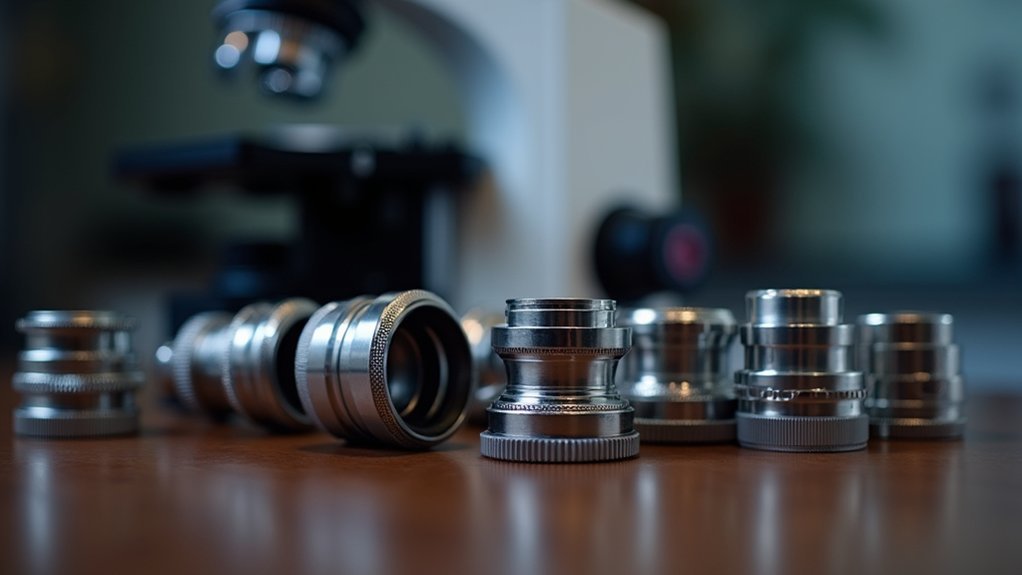
When exploring the microscopic world with your Nikon camera, a T-Mount adapter becomes an important piece of equipment.
These versatile adapters connect your Nikon camera directly to various microscopes, creating a powerful imaging system for capturing detailed microscopic subjects.
You’ll need to match your adapter to your specific Nikon mount type—either F-mount for DSLR models or Z-mount for mirrorless cameras.
The standardized thread design of T-Mount adapters guarantees compatibility across numerous microscope brands, giving you flexibility in your setup.
For enhanced imaging capabilities, you can attach additional optical elements between your camera and microscope.
Remember that proper alignment of your T-Mount adapter is vital—even slight misalignments can affect focus and image clarity when working at microscopic scales.
C-Mount vs. F-Mount Options for Nikon Microscope Cameras
When selecting between C-Mount and F-Mount options for your Nikon microscope camera, you’ll need to evaluate the compatibility differences outlined in our adapter chart below.
C-Mount systems typically deliver superior microscopy resolution at high magnifications due to their shorter 17.5mm registration distance compared to F-Mount’s 46.5mm.
Your optical path requirements will determine the ideal choice, as C-Mount adapters excel in dedicated microscopy applications while F-Mount options offer greater flexibility with existing Nikon lens collections.
Adapter Compatibility Chart
Understanding the differences between C-Mount and F-Mount adapters is essential for selecting the right connection for your Nikon microscope camera setup.
C-Mount adapters primarily connect microscope cameras to specialized optics, while F-Mount adapters serve a broader photographic purpose.
The FT-1 Lens Mount Adapter lets you use Nikon lenses with Nikon 1-System cameras, though it works best with AF-S and AF-P lenses. When using an Adapter for Nikon F-mount lenses on Nikon 1 cameras, you’ll experience a 2.7X crop factor—a 12mm lens effectively becomes 32mm.
F-Mount adapters offer greater lens compatibility across Nikon’s DSLR and mirrorless lineup, whereas C-Mount adapters are more microscope-specific.
Your choice depends on whether you need specialized microscopy connections or want to use standard photographic lenses with your camera system.
Microscopy Resolution Differences
Although both adapter types can connect cameras to microscopes, C-mount and F-mount options deliver noticeably different resolution results in microscopy applications.
C-mount adapters are specifically designed for microscope cameras, providing optimized optical performance for high-magnification imaging.
While F-mount options work well with Nikon DSLRs for photography, they’re less suited for microscopy applications. You’ll find C-mount adapters deliver superior resolution and contrast in your imaging setup compared to F-mount alternatives, which may introduce quality limitations.
When configuring your Nikon microscope cameras, consider your specific requirements carefully.
C-mount adapters generally yield better results for scientific microscopy where precision is essential. The standardized interface of C-mount systems guarantees consistent resolution across various microscopy applications, making them the preferred choice for professional microscopic imaging.
Optical Path Considerations
The optical path differences between C-mount and F-mount adapters considerably impact image quality when connecting cameras to Nikon microscopes. When selecting an adapter, you’ll need to account for the registration distance—46.5mm for Nikon F Mount versus 17.5mm for C-Mount—to guarantee proper focus and minimize image degradation.
| Camera Mount | Registration Distance | Optical Quality Considerations |
|---|---|---|
| Nikon F Mount | 46.5mm | Maintains full optical performance with native lenses |
| C-Mount | 17.5mm | Requires careful calibration for ideal focus |
| Adapter Rings | Varies | May introduce additional glass elements affecting clarity |
C-Mount adapters offer standardized compatibility across various microscope models, while F-Mount options provide flexibility with different lens selections. Remember that additional adapter elements in the optical path may affect resolution, so choose adapters designed specifically for your microscope cameras.
Trinocular Tube Adapters for DSLR and Mirrorless Nikon Bodies
You’ll find a range of trinocular tube adapters designed specifically for Nikon DSLR F-mount and mirrorless Z-mount systems, allowing for seamless integration with microscopes and telescopes.
These adapters offer varying mounting configurations, from direct attachments to those requiring intermediate tubes or additional optics for proper magnification.
Before purchasing, check your specific Nikon model’s compatibility, as certain adapters may work exclusively with either DSLR or mirrorless bodies, while others offer cross-platform flexibility.
Mounting Options Available
When exploring trinocular tube adapters for your Nikon equipment, you’ll encounter a range of mounting options designed to bridge microscopy with photography. The most common interfaces include the traditional Nikon F-mount for DSLR cameras and the newer Z-mount for mirrorless bodies, ensuring broad compatibility across Nikon’s ecosystem.
These trinocular tube adapters offer more than just camera attachment. You’ll find models with adjustable eyepiece diopters for precise focusing and ports for additional optics that enhance your viewing experience.
Many adapters also include mounting points for supplementary devices like video cameras or smartphone holders.
For scientific and educational applications, these adapters greatly improve image recording capabilities. You can document specimens with exceptional detail while maintaining the flexibility to explore creative possibilities through various attachment configurations.
Compatibility Across Bodies
Examining the compatibility landscape of trinocular tube adapters reveals significant differences between Nikon’s DSLR and mirrorless systems.
When selecting trinocular adapters for your Nikon DSLR, make sure they’re designed specifically for the F-mount to maintain proper alignment and functionality.
Your lens type will determine compatibility with these adapters. Most trinocular solutions support manual focus only, which means you’ll lose autofocus capabilities present in modern Nikon lenses. This limitation requires you to adjust your shooting technique accordingly.
For best image quality, verify that the registration distance of your trinocular adapter precisely matches your Nikon body’s specifications. Even slight misalignment can cause focusing problems throughout your image frame.
Mirrorless bodies like the Nikon 1-Series with CX mounts require different adapter configurations than their DSLR counterparts.
Step-Up and Step-Down Rings for Nikon Microscope Eyepieces
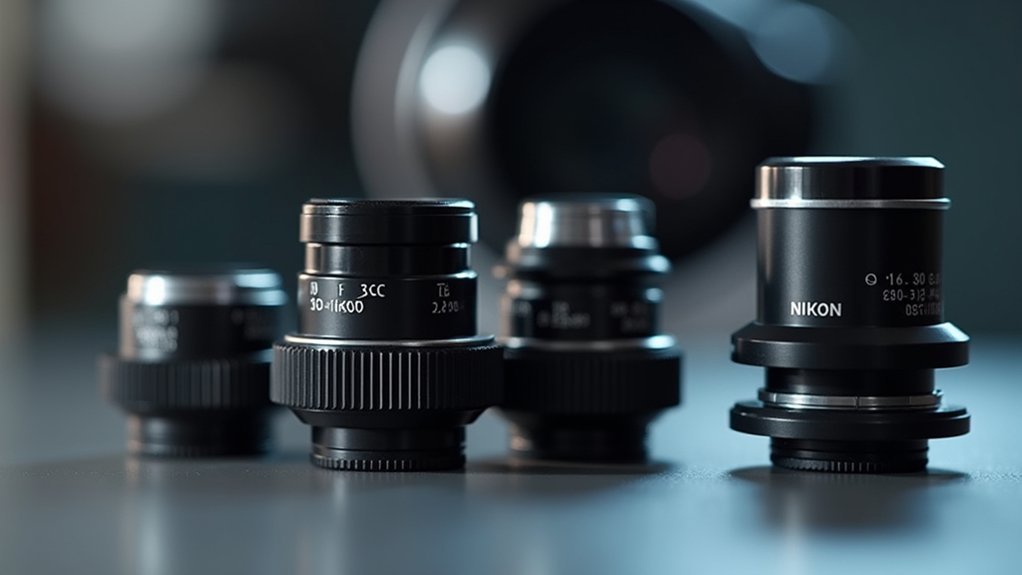
Connecting your camera to a Nikon microscope requires specific adapter rings that can bridge different diameter threads.
Step-up rings allow you to attach larger diameter lenses or filters to smaller Nikon microscope eyepieces, while step-down rings enable the opposite configuration.
Step-up and step-down rings bridge the size gap between your camera equipment and Nikon microscope eyepieces, ensuring proper mounting compatibility.
When selecting these adapters, you’ll need to check the threading specifications of both your eyepiece and camera lens to guarantee a secure fit.
These rings come in various sizes specifically designed for Nikon microscope systems, accommodating different lens mounts and focal lengths.
Proper ring selection is critical for maintaining ideal optical performance and minimizing vignetting in your microscopy photography.
The right combination of step-up or step-down rings will create a seamless connection between your camera and microscope, allowing you to capture clear, professional-quality microscopic images.
Specialized Adapters for Nikon Phase Contrast Microscopy
Specialized adapters for Nikon phase contrast microscopy serve as essential links between your camera and microscope, enabling detailed visualization of transparent specimens that would otherwise appear invisible under standard brightfield conditions.
These precision-engineered adapters guarantee peak optical performance through precise alignment mechanisms that minimize distortion in your captured images.
When selecting an adapter, you’ll need to verify compatibility with your specific microscope model. Many of these adapters are designed for particular Nikon cameras and microscopy setups.
The right adapter enhances your imaging capabilities considerably, revealing fine details vital for biological applications and medical research.
Some advanced models include built-in filters or adjustable apertures, giving you greater control over your microscopy imaging.
With these specialized tools, you’ll capture high-quality phase contrast images that highlight cellular structures with remarkable clarity.
Camera-to-Microscope Parfocal Distance Considerations
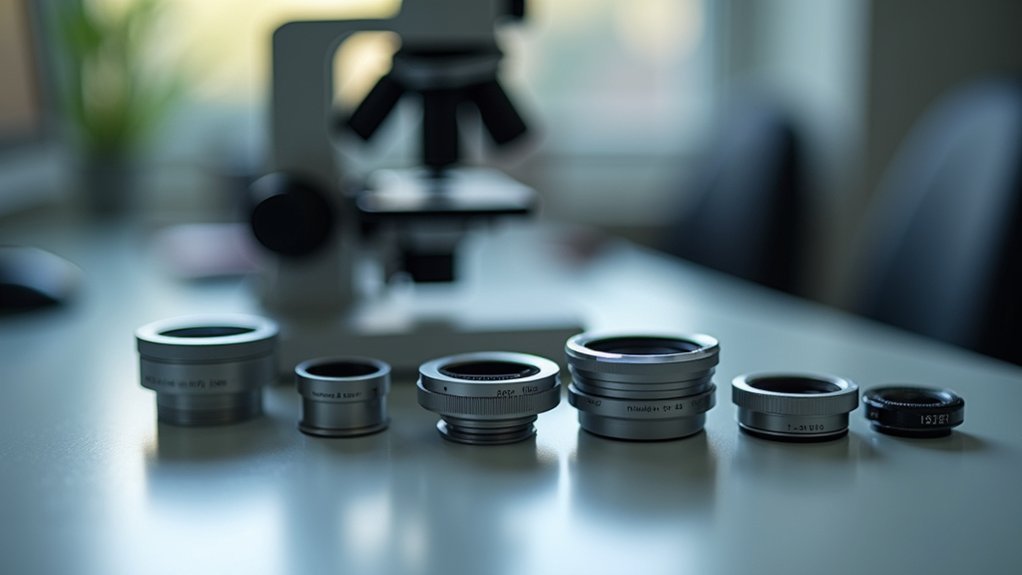
When attaching your Nikon camera to a microscope, proper parfocal distance becomes a critical factor that determines imaging success. Most microscopes maintain a parfocal distance around 45mm, but this varies by microscope model, requiring careful adapter selection for your Nikon camera.
The camera-to-microscope connection must preserve the ideal optical path length. Any adapter you choose affects this distance and can alter your imaging results.
When lens adapters add length to the optical pathway, they may compromise the system’s ability to maintain focus when switching between objectives.
Always check both your camera specifications and microscope documentation before purchasing adapters. This verification guarantees the combined setup maintains proper parfocal distance, allowing your Nikon camera to capture consistently clear, well-focused images across all objective magnifications.
Third-Party Adapter Solutions for Nikon Microscope Systems
A multitude of third-party adapters now expand Nikon microscope compatibility beyond factory limitations.
You’ll find options like the M42 screw mount to Nikon F mount adapters that let you connect vintage lenses to your microscope, greatly broadening your imaging capabilities.
Many adapters feature built-in aperture control dials, allowing you to make precise adjustments to lighting and depth of field while capturing microscopic specimens.
Whether you’re using standard or professional-grade lenses, these adapters guarantee versatility across different magnifications.
When selecting an adapter for your Nikon microscope system, pay careful attention to the registration distance.
This critical measurement determines proper focusing and ultimately affects image clarity.
With the right third-party adapter, you’ll maximize your microscope’s potential while maintaining Nikon’s renowned optical quality.
Calibration and Alignment Tips for Nikon Microscope Adapters
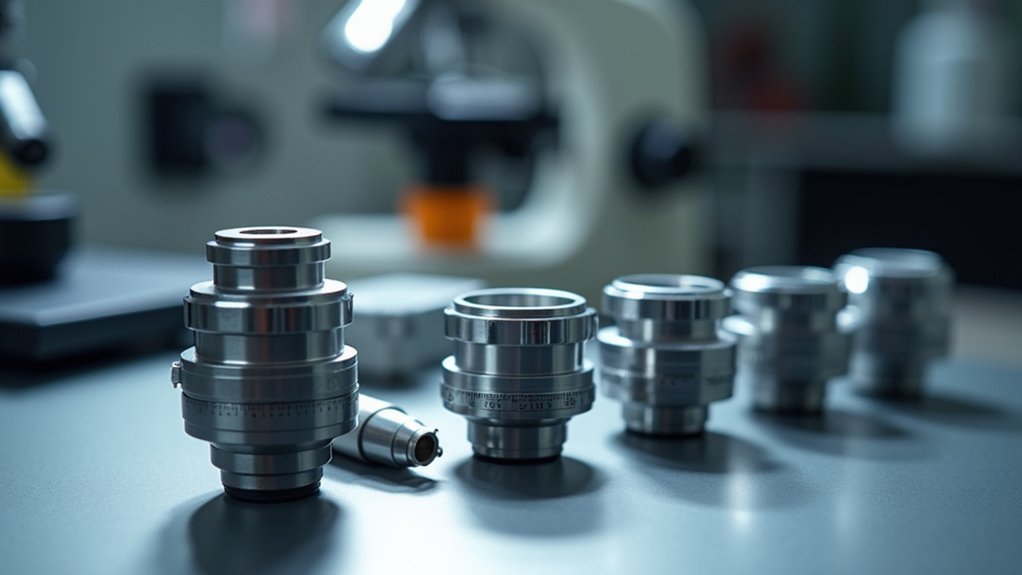
Once you’ve selected the perfect adapter for your Nikon microscope, proper calibration and alignment become your next focus.
Verify the optical axis aligns precisely with your camera sensor to prevent distortion in your microscopic images.
Use calibration targets with known dimensions to validate your imaging system’s accuracy and make necessary focus adjustments.
Don’t overlook regular cleaning of the adapter’s mounting surfaces—this maintains ideal light transmission and image clarity.
Adjust your camera settings to match your microscope’s specific lighting conditions. Fine-tuning exposure and ISO values will greatly enhance your final images.
Remember that proper alignment between all components is vital for consistent results.
Always consult your specific adapter’s manufacturer guidelines to confirm proper installation and compatibility with your camera system.
Frequently Asked Questions
What Is a Nikon FTZ Adapter?
A Nikon FTZ adapter lets you use your F-mount lenses on Z-series mirrorless cameras. You’ll maintain autofocus and exposure functionality with most AF-S and AF-P lenses while enjoying weather-sealed protection during shoots.
What Cameras Do Nikon Lenses Work With?
Nikon lenses work primarily with Nikon cameras. You’ll find they’re fully compatible with Nikon DSLRs and can work with Nikon mirrorless Z-series cameras using the FTZ adapter. Some functionality may be limited with older lens models.
Do Camera Lens Adapters Affect Image Quality?
Yes, lens adapters can affect your image quality. You’ll notice potential issues like reduced sharpness, added distortion, or light loss, especially with adapters containing optical elements to maintain focus capabilities.
What Is the FT1 Adapter for Nikon?
The FT-1 adapter lets you mount F-mount NIKKOR lenses on Nikon 1 Series cameras. You’ll get a 2.7x crop factor, and it’s most compatible with AF-S and AF-P lenses for full autofocus functionality.
In Summary
When choosing adapters for your Nikon microscope system, you’ll need to match the specific mount type (T, C, or F) with your equipment. Don’t forget to take into account parfocal distance and proper calibration for best results. While Nikon’s proprietary options provide seamless integration, third-party solutions can offer cost-effective alternatives. Remember that step rings and specialized adapters for techniques like phase contrast may be necessary for your specific application.

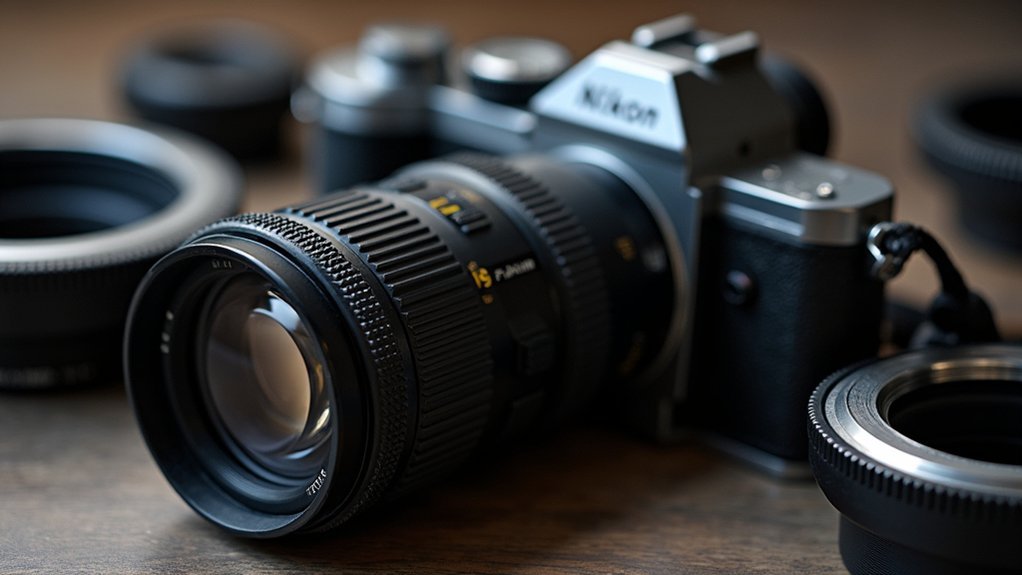



Leave a Reply